Posts Tagged ‘Malta’
-
A MATTER OF FATE
For British diplomat John Hookham Frere, January became a month of sorrows….
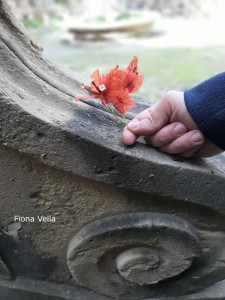 Some say that bad luck isn’t real and that there is no such thing as luck. Yet others would strongly avoid walking under a ladder or crossing the street in the presence of a black cat. They will certainly not open an umbrella indoors or drink any water that reflects moonlight, in the fear of attracting misfortune. Still, there are those who insist that whether you see it as lucky or unlucky, the chance event is the same. But is it?
Some say that bad luck isn’t real and that there is no such thing as luck. Yet others would strongly avoid walking under a ladder or crossing the street in the presence of a black cat. They will certainly not open an umbrella indoors or drink any water that reflects moonlight, in the fear of attracting misfortune. Still, there are those who insist that whether you see it as lucky or unlucky, the chance event is the same. But is it?John Hookham Frere, a British diplomat, poet, scholar and philanthropist, is not known to have spoken of bad luck. However, when years went by and he started to suffer the loss of his loved ones all during the same month, he lamented that January was becoming too melancholic for him.
Rumours say that his mother Jane, daughter of John Hookham (senior) who was a rich London merchant, had brought an astrologer’s silver cup as part of her marriage dowry. This cup originally belonged to her great uncle, John Dee, who was believed to be a conjurer. Legend said that he had used the cup to make some supernatural experiments but she insisted that this was not true. In defiance, she used the cup as a sugar bason.
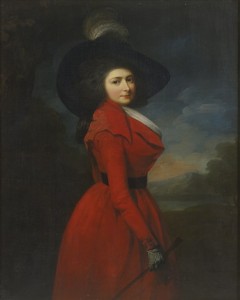 Curiously, the ‘January calamity’ had already struck the woman that Frere would eventually marry – Elizabeth Jemima Blake. A portrait painted by Sir Martin Shee shows her as a very beautiful girl with large dark eyes and masses of dark hair. In January 1790, she married George, sixteenth Earl of Erroll, who committed suicide in June 1798 after he confided an official secret to a friend who then published the communication and its author.
Curiously, the ‘January calamity’ had already struck the woman that Frere would eventually marry – Elizabeth Jemima Blake. A portrait painted by Sir Martin Shee shows her as a very beautiful girl with large dark eyes and masses of dark hair. In January 1790, she married George, sixteenth Earl of Erroll, who committed suicide in June 1798 after he confided an official secret to a friend who then published the communication and its author.The childless and beautiful widow met Frere in the year 1800 when she was recommended to stay in Lisbon to alleviate her mourning sorrows. At the time, Lisbon was a favourite health resort and Frere, who had just been appointed Envoy to the Court of Lisbon, was requested by a common friend to take care of her. Soon, the two became very good friends and along the years, they kept in contact through letters. Eventually, they got married on the 12th September 1816.
Lady Erroll never regained her health completely and this was a constant source of anxiety to her husband. A severe cold which she got while visiting the new rooms that were built at the British Museum for the Elgin marbles, wrought permanent damage to her constitution. A serious illness in 1820 obliged Frere to take her abroad and although she recovered some strength while travelling in the Mediterranean, it was clear that she would not survive the cold English climate.
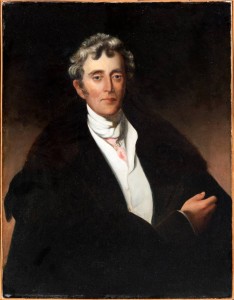 Since Frere preferred to live among English subjects, he chose to move to Malta. His sister Susanna, who had never married and who offered to help him to take care of his wife, joined them too. Initially, they resided in Casa Correa, a palatial building in Old Bakery Street, Valletta. Later on, they moved to Pietá, where they acquired two adjoined buildings, so that Susanna could live close by. This house on the waterfront helped Elizabeth to recover to better health and Frere began to show interest in the Maltese Islands which were so rich in history.
Since Frere preferred to live among English subjects, he chose to move to Malta. His sister Susanna, who had never married and who offered to help him to take care of his wife, joined them too. Initially, they resided in Casa Correa, a palatial building in Old Bakery Street, Valletta. Later on, they moved to Pietá, where they acquired two adjoined buildings, so that Susanna could live close by. This house on the waterfront helped Elizabeth to recover to better health and Frere began to show interest in the Maltese Islands which were so rich in history.Frere was very proficient in languages, namely Greek, Latin, Italian, French and Spanish. In Malta, he extended his knowledge in the Maltese and Hebraic languages. His ample library filled with prestigious and rare books became renowned with scholars, some of whom came to visit from abroad. At this time, he met Mikiel Anton Vassalli, a Maltese writer, linguist and philosopher.
Vassalli was expelled from Malta a number of times due to his political beliefs. His troubled life led to much difficulties and Frere helped to alleviate some of his problems. He financed the education of his three sons, supported him to publish his books and helped him to start teaching at the University of Malta as the first Professor of Maltese language. Frere’s remarkable kindness persisted even after Vassalli’s death, on 12th January 1829, when he took the responsibility of his burial in the then Protestant cemetery of the Msida Bastion, after the Catholic Church refused to do so due to his alliance with the Protestants.
Almost two years later, Frere had to return to these burial grounds again, this time to bury his wife when she passed away on 17th January 1831. His wife’s loss overwhelmed him with grief but he refused to return to England even though his relatives and friends advised him to do so. Eventually, he decided to acquire the steep hill behind his house in Pietá, turning the landscape into a set of lovely fertile terraces that were embellished with refined temples. From these peaceful gardens, he could look out at the cemetery where his beloved was resting.
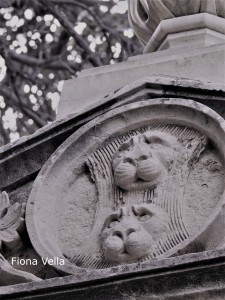 Yet the ominous month was set to claim another victim, this time his sister Susanna who died on the 18th January 1839, eight years and a day following the demise of his wife.
Yet the ominous month was set to claim another victim, this time his sister Susanna who died on the 18th January 1839, eight years and a day following the demise of his wife.In some letters which Frere wrote to his relatives and friends, he expressed his regret that the penalty of a long life was to see all those whom he had loved wither away and die. While his earlier years had been dedicated to political writing and literary satires, he passed the last years of his life composing epitaphs.
Instead of bringing an elation of joy at the beginning of a new year, January became acutely associated with death and Frere simply hated it. Who could have told him that this month would ultimately also claim his life – on 7th January 1846.
Currently, Heritage Malta holds the title for the iconic gardens of Villa Frere in Pietá. In February 2019, Heritage Malta and the NGO Friends of Villa Frere, signed a partnership and management agreement for the promotion, public availability, and the running and operation of the historical site.
The gardens of Villa Frere are opened for the public once a month or by appointment for groups. For further information, contact the NGO Friends of Villa Frere on Facebook or by email on villafrere@gmail.com
(This feature was published in the SENIOR TIMES – JANUARY issued with the Times of Malta dated 24 January 2020)
-
MALTA’S PREHISTORIC TREASURES
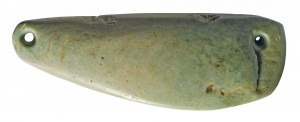 Who knows whose neck the exotic jadeite amulet adorned? To reach the Maltese shores, this item travelled a very long distance in prehistoric times. Therefore, it must have been really treasured, raising the status of its owner. It is difficult to see a symbolic meaning in such an amulet, however, it was chosen to accompany an individual who was laid to rest at the Xagħra Circle in Gozo.
Who knows whose neck the exotic jadeite amulet adorned? To reach the Maltese shores, this item travelled a very long distance in prehistoric times. Therefore, it must have been really treasured, raising the status of its owner. It is difficult to see a symbolic meaning in such an amulet, however, it was chosen to accompany an individual who was laid to rest at the Xagħra Circle in Gozo.We all know that person who would throw nothing away, and keeps mending an object till the very last. Well, it seems that such persons have existed since prehistoric times. A jar which was unearthed at Skorba Temples was drilled with pairs of holes above and below the crack to tie the two parts together with a long string. Who could tell whether these interventions served their purpose?
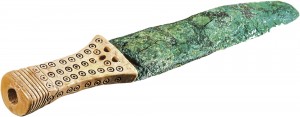 To whom did the elegant bone and copper dagger, that was discovered at Għar Mirdum in Dingli Cliffs, belong? Clearly designed for prestige rather than for defence, such a lovely object is unlikely to have been casually lost. So why was it left in this buried cave?
To whom did the elegant bone and copper dagger, that was discovered at Għar Mirdum in Dingli Cliffs, belong? Clearly designed for prestige rather than for defence, such a lovely object is unlikely to have been casually lost. So why was it left in this buried cave?Was the heavily pregnant female clay figure which was found at the Tarxien Temples, pierced in sixteen places with sharp fragments of shell, really intended to curse an opponent by magical means? And did the magic spell work?
While the first clay figure of the Sleeping Lady that was found in the Hypogeum of Ħal Saflieni rested on its side, another one discovered at the same site, lies face down with her breasts hidden beneath her. If either or both these figures could come to life, they would tell us a great deal about what we should dearly like to know about themselves and their times, though we might have great difficulty in understanding what they had to say. What would it take to wake them up?
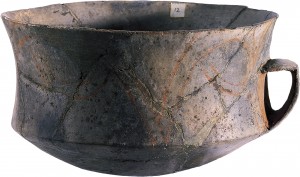 Archaeological discoveries are not only made in main sites. Nearby locations could be as significant for further revelations. The remains of a carinated clay offering bowl was recovered during investigations in the North Cave at the megalithic site of Ġgantija. Decorated with coloured scratched volutes, this bowl must have been considered sacred enough so as not to be casually scattered. It would be so intriguing to know in which rituals it was used.
Archaeological discoveries are not only made in main sites. Nearby locations could be as significant for further revelations. The remains of a carinated clay offering bowl was recovered during investigations in the North Cave at the megalithic site of Ġgantija. Decorated with coloured scratched volutes, this bowl must have been considered sacred enough so as not to be casually scattered. It would be so intriguing to know in which rituals it was used.These are only a few of the engaging narratives which form part of the collection of fifty artefacts in Heritage Malta’s latest publication “Malta’s Prehistoric Treasures”.
Skillfully chosen from the National Collection by the renowned late archaeologist Dr. David Trump, the artefacts are intended to accompany the readers along a personal journey in Maltese prehistory which fascinated him so much.
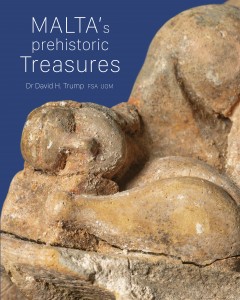 This makes the book even more significant since the selected artefacts are not only allowing the readers to learn about the local prehistoric people but also to see through the eyes of a very inspirational archaeologist.
This makes the book even more significant since the selected artefacts are not only allowing the readers to learn about the local prehistoric people but also to see through the eyes of a very inspirational archaeologist.The book has an additional narrative by Heritage Malta Senior Curator, Sharon Sultana.
Photography and design by Daniel Cilia.
Malta’s Prehistoric Treasures is available from Heritage Malta sites and museums.
For more information, visit www.heritagemalta.org
(This feature was published in The Times of Malta issued on 30th December 2019)
-
THE MAGIC IS IN THE DETAIL
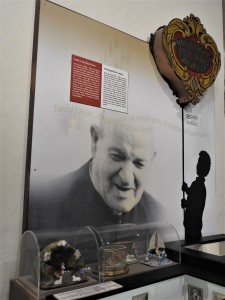 Although the main characters of the nativity scene are Joseph, Mary and baby Jesus, different cultures have added and altered the original representation in order to include their own characteristics. Some of these varying interpretations can be viewed in a permanent exhibition at the Inquisitor’s Palace in Birgu, which also houses the National Museum of Ethnography.
Although the main characters of the nativity scene are Joseph, Mary and baby Jesus, different cultures have added and altered the original representation in order to include their own characteristics. Some of these varying interpretations can be viewed in a permanent exhibition at the Inquisitor’s Palace in Birgu, which also houses the National Museum of Ethnography.In Malta, it was St George Preca (1880 – 1962) who fostered a lasting Christmas cult through his Society of Christian Doctrine. On Christmas Eve of 1921, he organized the first procession with a statue of baby Jesus. He also started the tradition of giving a crib and a statue of baby Jesus to every child who attended the MUSEUM centres.
In the exhibition, an image of Preca looks over at a rudimentary crib which has initiated a tradition that is still celebrated nowadays. A detailed diorama portrays further this tradition, showing a MUSEUM Superior handing out a crib to a boy, while a number of other children are already joyfully holding their cribs. An altar which is included in the diorama is decorated with flowing white vetch.
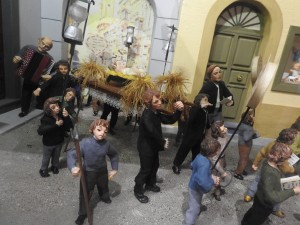 Another diorama looks like a time capsule showing the traditional procession of baby Jesus together with other local customs. Not only can one observe the MUSEUM members carrying the statue of baby Jesus, but one can also delight at the children carrying lights and Christmas messages while singing Christmas carols. The context is further enriched by the presence of traditional Maltese town houses, with their colourful wooden doors and with their wide open windows decorated with a small statue of baby Jesus.
Another diorama looks like a time capsule showing the traditional procession of baby Jesus together with other local customs. Not only can one observe the MUSEUM members carrying the statue of baby Jesus, but one can also delight at the children carrying lights and Christmas messages while singing Christmas carols. The context is further enriched by the presence of traditional Maltese town houses, with their colourful wooden doors and with their wide open windows decorated with a small statue of baby Jesus.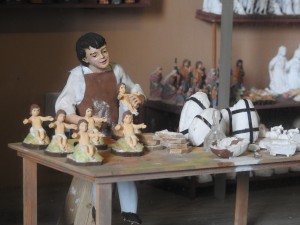 These two dioramas form part of a set that was donated to Heritage Malta by Austin Galea; a well-established artisan and personality among local crib enthusiasts, and a founding member of the Għaqda Ħbieb tal-Presepju (Malta). The set of dioramas give life to further Christmas traditions, such as the sermon of the altar boy during Christmas’ eve mass, a large crib displayed for public viewing, a group of craftsmen in a workshop manufacturing statues and cribs, and a Christmas lunch being enjoyed by a family.
These two dioramas form part of a set that was donated to Heritage Malta by Austin Galea; a well-established artisan and personality among local crib enthusiasts, and a founding member of the Għaqda Ħbieb tal-Presepju (Malta). The set of dioramas give life to further Christmas traditions, such as the sermon of the altar boy during Christmas’ eve mass, a large crib displayed for public viewing, a group of craftsmen in a workshop manufacturing statues and cribs, and a Christmas lunch being enjoyed by a family.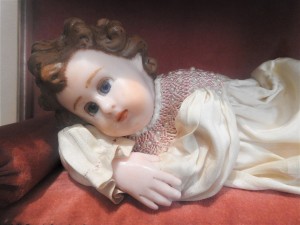 Galea has also donated two large nativity scenes which are typically exhibited in windows of private houses during the Christmas season in Malta. Other donations by him include different traditional statues of baby Jesus. Traditionally, the baby Jesus statues were made of wax to obtain a soft and translucent finish. The statues were eventually dressed up in an embroidered tunic, while many borrowed real hair from a toddler’s crowning curls.
Galea has also donated two large nativity scenes which are typically exhibited in windows of private houses during the Christmas season in Malta. Other donations by him include different traditional statues of baby Jesus. Traditionally, the baby Jesus statues were made of wax to obtain a soft and translucent finish. The statues were eventually dressed up in an embroidered tunic, while many borrowed real hair from a toddler’s crowning curls.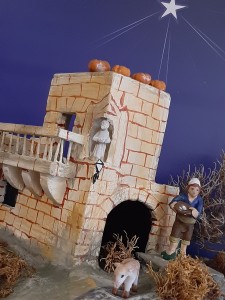 A large Maltese crib is also part of Galea’s generous donation. The crib is a comprehensive study of Maltese traditions in itself. Typical Maltese figurines are dressed in traditional local costumes, and among them, one also finds the unique Maltese symbolic characters. The Stupefied figurine represents those who are impressed by the profound meaning of the unique happening. The Beggar represents the poor who find consolation in Christ. The Climber represents those who find it difficult to understand the significance of Christ’s incarnation but strive to discover out. The Folk Singers represent communal association in praising the Lord, while the Sleeper represents those who ignore the immeasurable benevolence of Christ. The rugged landscape with its terraced fields, sparse vegetation, low-profile unpretentious farmhouses and a windmill are reminiscent of the rural ambience of the old times.
A large Maltese crib is also part of Galea’s generous donation. The crib is a comprehensive study of Maltese traditions in itself. Typical Maltese figurines are dressed in traditional local costumes, and among them, one also finds the unique Maltese symbolic characters. The Stupefied figurine represents those who are impressed by the profound meaning of the unique happening. The Beggar represents the poor who find consolation in Christ. The Climber represents those who find it difficult to understand the significance of Christ’s incarnation but strive to discover out. The Folk Singers represent communal association in praising the Lord, while the Sleeper represents those who ignore the immeasurable benevolence of Christ. The rugged landscape with its terraced fields, sparse vegetation, low-profile unpretentious farmhouses and a windmill are reminiscent of the rural ambience of the old times.Besides donating his first clay crib figurines which were given to him by his aunties and an unusual crib made of sacks that was constructed by him, Galea shares also his knowledge relating to Christmas crib construction in a short video which forms part of this exhibition.
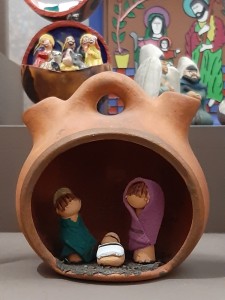 Another intriguing element in this exhibition is the donation of numerous miniature cribs which were brought by Albert and Lina McCarthy from all over the world. The professional tour managers have been gathering this impressive collection since the early 90s. Their collection amounts to more than 500 miniature works of art, a representative selection of which is on display at the Inquisitor’s Palace.
Another intriguing element in this exhibition is the donation of numerous miniature cribs which were brought by Albert and Lina McCarthy from all over the world. The professional tour managers have been gathering this impressive collection since the early 90s. Their collection amounts to more than 500 miniature works of art, a representative selection of which is on display at the Inquisitor’s Palace.Exhibited in four different sections, the varying nativity scenes representing North and East Europe, Southern Europe and the Near East, North and South America, and Africa, Asia, the Far East and Australia are simply enchanting. The magic is in the detail of each crib which presents the nativity scene in various contexts, with distinct characters and in diverse materials.
 Some of the most notable are the terracotta nativity sets from Hungary and Peru, the ceramic sets from Denmark and the Philippines, the engraved wooden shoe from Amsterdam, the wooden sets of Germany, Austria, Japan and Iran, the metallic artwork from Bali, the sack nativity set from Sri Lanka and the clay figurines of North Africa set in a bedouin tent, dressed in traditional costumes and accompanied by a camel instead of farm animals.
Some of the most notable are the terracotta nativity sets from Hungary and Peru, the ceramic sets from Denmark and the Philippines, the engraved wooden shoe from Amsterdam, the wooden sets of Germany, Austria, Japan and Iran, the metallic artwork from Bali, the sack nativity set from Sri Lanka and the clay figurines of North Africa set in a bedouin tent, dressed in traditional costumes and accompanied by a camel instead of farm animals.A visit to this permanent exhibition held at the Inquisitor’s Palace is most educational and entertaining for children, and also curious and insightful for adults. The exhibits are a tribute to local and foreign artisans who have used their creativity to reproduce the significant nativity scenes in various intriguing representations.
(Published in Christmas Times magazine issue with The Times of Malta dated 7th December 2019)
-
THE SELLING GAME
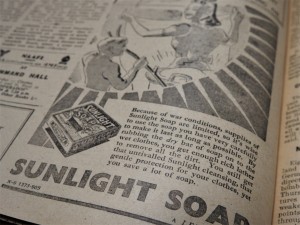 Advertising is said to reflect the societal tastes, beliefs and norms. By looking back at the adverts that were published in the Times of Malta at the end of the years 1939 to 1944, this becomes very clear. Yet even their absence during the days of war have much to say.
Advertising is said to reflect the societal tastes, beliefs and norms. By looking back at the adverts that were published in the Times of Malta at the end of the years 1939 to 1944, this becomes very clear. Yet even their absence during the days of war have much to say.There are whole studies and much research behind advertising. Adverts are used as a form of communication intended to convince an audience to purchase or take some action upon products, ideals or services. Their regularity aim to impact on memory to create a sense of familiarity and trust to buy those products.
Indeed, while turning the pages of November – December 1939 and 1940 of the Times of Malta, it is evident that a group of particular brands are always featuring. Most relate to health, beauty, alcohol, insurance, entertainment (mainly cinema), fashion and gifts.
Health adverts at the time generally focus on irritability of the stomach, laxatives, cold and fever, rheumatism, eczema, fatigue and sleeplessness. The message on the adverts is mainly delivered through drawings and long descriptions about the benefits of using the products.
 The text is generally presented in the form of a conversation – “Why continue to be agonised by Terrible Headaches, Niggling Nerve Pains, Black Depression, and Heavy-Limbed Lassitude?” – reads the introduction of an advert for tonic tablets.
The text is generally presented in the form of a conversation – “Why continue to be agonised by Terrible Headaches, Niggling Nerve Pains, Black Depression, and Heavy-Limbed Lassitude?” – reads the introduction of an advert for tonic tablets.“Do you realise the danger? Impure blood causes disease.” – says another advert selling a ‘blood mixture’ as ailment against rheumatism, lumbago, eczema, boils and pimples.
Communication with the readers is stark and direct – The word “Poisoned!” in capital black letters runs over the mouth of a man in the advert of a toothpaste. “Pyorrhoea has robbed him of his teeth, poisoned his whole system. Don’t let this happen to you.”
“Is running a house too much for you?” reads the title of an energy drink. “Do you feel that the cares of the household get you down and managing your servants is a strain?”
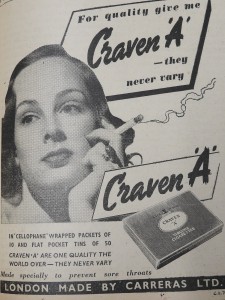 The quantity of adverts focusing on health issues form quite a big chunk of the advertising at the time. However, ironically, these are accompanied by cigarette adverts, one of which shows a beautiful young woman with a cigarette in her hand. A section of the advert text reads – “Made specially to prevent sore throats.”
The quantity of adverts focusing on health issues form quite a big chunk of the advertising at the time. However, ironically, these are accompanied by cigarette adverts, one of which shows a beautiful young woman with a cigarette in her hand. A section of the advert text reads – “Made specially to prevent sore throats.”Some of the adverts published at the time will certainly be unacceptable nowadays. Social class differences, sexism and offensive messages are quite typical.
“Women who belong to the 1st sleep group never grow old before their time. There are 3 groups. Which do you belong to?” – asks an advert selling Horlicks. “Most attractive women belong to the 1st sleep group.” – states another one. “Men who are sure of themselves belong to the 1st sleep group.” – and – “Men who get on in life nearly all belong to the 1st sleep group”.
 “Don’t look old! Tint those grey hairs with Shadeine.” – jumps at you an advert selling hair colour.
“Don’t look old! Tint those grey hairs with Shadeine.” – jumps at you an advert selling hair colour.Advertisements can influence strongly how we perceive things around us. By showing a high social class user of a product, the advert creates a longing or a pressure to purchase that item in order to belong to that level of society.
A skin-vitamin cream portrays the drawing of a beautiful lady, all dressed up in perfect make-up, set-up hair, a pair of lovely earrings and a crown. – “Lady Grenfell is one of the most beautiful among the young marrieds in Society…. She tells us, ‘I’m using Pond’s Creams containing the ‘skin-vitamin’, and they’re really amazing.”
“Many army and royal navy officers enjoy the comfort of our hand-made footwear. Why Not you? Sir.” – entices an advert showing the drawing of a highly elegant man sitting in a luxurious armchair while a shoe-maker sits on a stool to help him try on a new pair of shiny “Best English leather”.
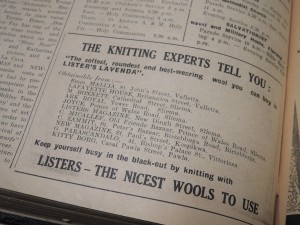 A shade of the effects of the Second World War, even though not yet happening in Malta is already present in adverts of 1939.
A shade of the effects of the Second World War, even though not yet happening in Malta is already present in adverts of 1939.“Keep yourself busy in the black-out by knitting with Listers – the nicest wool to use.” – advices an advert. “Bernards suggest that you give sensible gifts this Christmas. Such gifts as shirts, pyjamas, handkerchiefs, ties, socks, gloves and wool-slipovers all make very acceptable presents.” – recommends another one.
Not only adverts diminish in 1941 during the war days in Malta. Even the newspaper itself shrivels to a few pages although being published daily.
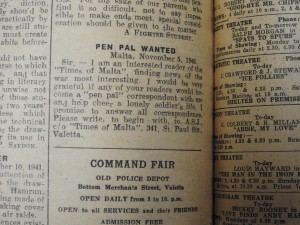 “Test your gas mask. Gas Chamber at Castile Place today.” – reads a warning advert on the front page of the Times of Malta on Tuesday, November 4, 1941. “There is no better way of ensuring that the respirator is still properly functioning than by putting it on and entering the gas chamber.”
“Test your gas mask. Gas Chamber at Castile Place today.” – reads a warning advert on the front page of the Times of Malta on Tuesday, November 4, 1941. “There is no better way of ensuring that the respirator is still properly functioning than by putting it on and entering the gas chamber.”Amid the difficulties of war, an advert speaks out the request for a pen pal – “I am an interested reader of the “Times of Malta”, finding news of the war most interesting. I would be very grateful if any of your readers would become a “pen pal” correspondent with me and help cheer a lonely soldier’s life.”
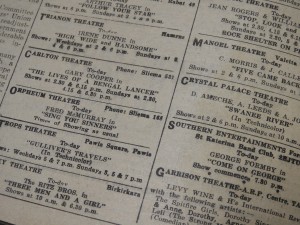 A considerable decrease of adverts continues in 1942. Alcohol adverts drop out completely. Cinema continues regularly in the following theatres – Manoel and Coliseum in Valletta, Gaiety, Majestic, Carlton and Orpheum in Sliema, Odeon, Thrianon and Rex in Ħamrun, Prince in Birkirkara, Buckingham and Royal in Żabbar, and Empire in Paola.
A considerable decrease of adverts continues in 1942. Alcohol adverts drop out completely. Cinema continues regularly in the following theatres – Manoel and Coliseum in Valletta, Gaiety, Majestic, Carlton and Orpheum in Sliema, Odeon, Thrianon and Rex in Ħamrun, Prince in Birkirkara, Buckingham and Royal in Żabbar, and Empire in Paola.“What do I do…. about the black market?” runs an advert issued by the Information Office. A Wartime Reminder advert issued by the same Office reminds people that “Imported Fuel is used for pumping Water. Reduced consumption of water saves Fuel. A saving in Fuel saves Freight, (and) Saving in freight helps to win the War.”
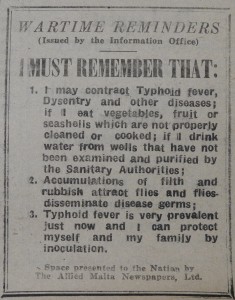 Another Wartime Reminder recommends the adequate washing of vegetables, fruit and seashells, and their proper cooking while warning against the accumulation of filth, since these may lead to Typhoid fever and Dysentry. Inoculation against the Typhoid fever is also advocated.
Another Wartime Reminder recommends the adequate washing of vegetables, fruit and seashells, and their proper cooking while warning against the accumulation of filth, since these may lead to Typhoid fever and Dysentry. Inoculation against the Typhoid fever is also advocated.The siege on the Maltese Islands effectively ended in November 1942. Yet adverts show that life took time to return to normal especially since the Second World War had not yet ended in other countries.
An advert issued by the N.F.U advices to eat cabbage and cauliflower to keep fit. Another advert informs its clientele that “Because of war conditions, supplies of Sunlight Soap are limited, so it’s wise to use the soap you have very carefully to make it last as long as possible.”
Even tennis balls were restored instead of purchasing new ones – “Hand in your old Tennis Balls to any of the Sports Dealers named below, who will forward them to Slazengers for renovation by a special process which includes reinflation and provision of a new outside cover.”
During the days of war, a few selected companies such as Bovril, managed to stay in the public eye through advertisements. “Makes all the difference between bread and butter.” The Bovril advert states. “A 4-oz. Bottle of Bovril makes over 100 delicious sandwiches.”
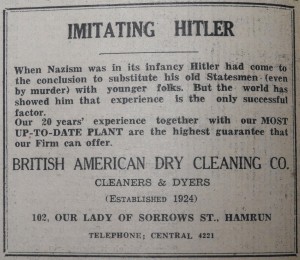 Other adverts such as the one for Dettol portrayed the company’s involvement in the war efforts and reminded that the product should be used with “measured care” in order to keep the supply flowing.
Other adverts such as the one for Dettol portrayed the company’s involvement in the war efforts and reminded that the product should be used with “measured care” in order to keep the supply flowing.Marketers have always adapted to changing business demands when it comes to creating new advertisements. However, there are moments when their creativity is quite shocking – “Imitating Hitler” screams the title in bold capital letters of the British American Dry Cleaning Co.
(This feature was published in the Christmas Supplement issued with the Times of Malta dated 1st December 2019)
-
THE SISTERS OF THE CRIB
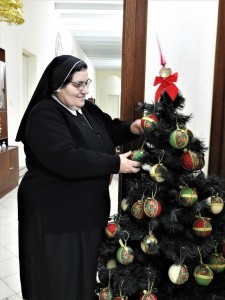 “This place was much livelier when children were around, especially in Christmas,” reminisced 60-year-old Madre Phyllis Agius of Jesus of Nazareth Institute in Żejtun. Around forty years ago, when she became a nun, the institute catered for orphans, teenage girls with family problems, and Muslim refugees. Nowadays, the nuns have dwindled to only nine and the institute serves mainly as a night shelter for the elderly.
“This place was much livelier when children were around, especially in Christmas,” reminisced 60-year-old Madre Phyllis Agius of Jesus of Nazareth Institute in Żejtun. Around forty years ago, when she became a nun, the institute catered for orphans, teenage girls with family problems, and Muslim refugees. Nowadays, the nuns have dwindled to only nine and the institute serves mainly as a night shelter for the elderly.“It was the need to take care of children which made me decide to become a nun. When I was a little girl, I noticed the institute’s orphans attending my same school in Żejtun and I hoped that one day, I would be able to give them all my love and support.”
She was initially approached by a nun while she was participating in a raffle which was being held at the institute as part of the Christmas activities.
“I visited the mechanical crib at this institute each year and like many others, I tried my luck at the raffle. On one of these days, I won the raffle but I had no idea which gift to choose. It was at that point that a nun gave me a pamphlet which read – Why not you? From then on, I began to consider becoming a nun.”
The large mechanical crib which was opened for the public in 1947, was one of the main attractions which brought people to the institute.
“People were simply amazed by this crib and its moving figurines. When it opened for the first time, crowds came from all over the island to see it. There were such long queues that people got restless waiting and the police had to be called in to calm the situation. By time, we became known as the sisters of the crib.”
 “No entrance fee was charged to visit this crib but people gave us donations to support the needs of our institute. Both this crib and also the orphans drew the attention of several benefactors who helped us to live a simple but comfortable life.”
“No entrance fee was charged to visit this crib but people gave us donations to support the needs of our institute. Both this crib and also the orphans drew the attention of several benefactors who helped us to live a simple but comfortable life.”Like Madre Phyllis, when I was young, I remember some of these young children who attended the primary school in Żejtun. They were always very smart and tidy.
“Older nuns recall a time when there were around two hundred children at this institute. There were not as many children when I became a nun, and the last group who lived here around twelve years ago, consisted of just six children. Although the children lived a disciplined life, they were all very dear to us, and some of them are still in contact with us.”
“Our children were always very busy during the Christmas season. Nuns trained them to participate in plays and also in the institute’s choir. A group of nuns who could play instruments organized a small orchestra which accompanied the choir. On Christmas eve, the Institute’s director would attend and he was always very pleased to see everyone having fun.”
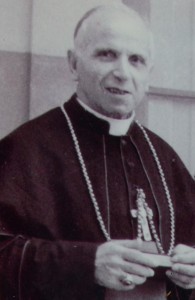 The first director of this institute and orphanage was none other than Bishop Emmanuel Galea, the very person who came up with the idea to construct the large mechanical crib.
The first director of this institute and orphanage was none other than Bishop Emmanuel Galea, the very person who came up with the idea to construct the large mechanical crib.“During the Christmas season, the children attended to many parties and they received several presents. Some of the children were also invited to spend the Christmas with families. It was such a happy time.”
“One of the nuns, Sister Ursola, was an excellent pastry maker. The aroma of baking Christmas cakes and qagħaq tal-għasel was heavenly during those days. Much of these sweets were given to our benefactors as a sign of gratitude.”
As no more children were left and fewer nuns joined the institute, life changed considerably. Now, most of the benfactors are gone and the elderly nuns have to rely on the help of friends and volunteers. Yet Christmas is still a cherished time.
“Three weeks before Christmas, we start with the Advent season which prepares us for the celebration of the Nativity of Jesus. This consists of teachings and readings during the daily mass that takes place at the institute’s church at 7.00am. Nine days before Christmas, we celebrate the novena which consists of readings and singing at the end of the mass.”
The expectation for Christmas triggers also a number of traditions within the institute.
“Volunteers come to help us to decorate the institute’s halls and rooms with cribs, baby Jesus statues, Christmas fathers and Christmas trees. One of the volunteers also takes care of growing vetch for us which is eventually used to decorate the institute’s church together with ponsiettas.”
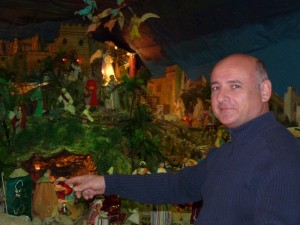 “Joseph Pavia, the nephew of Pawlu Pavia who constructed the mechanical crib, calls to check whether everything is fine with the crib and the figurines. In the meantime, we prepare the items for our Christmas bazaar from which we sell books, toys and crafts prepared by the nuns.”
“Joseph Pavia, the nephew of Pawlu Pavia who constructed the mechanical crib, calls to check whether everything is fine with the crib and the figurines. In the meantime, we prepare the items for our Christmas bazaar from which we sell books, toys and crafts prepared by the nuns.”The day before Christmas eve, Madre Phyllis prepares her renowned chocolate drink which has become a favourite with parishioners.
“My recipe consists of chunks of exquisite chocolate, drinking chocolate, baking chocolate, vanilla drops, sugar, and peel of oranges, lemons and mandarines. I melt and blend eveything together in two large cooking pots and leave the mixture to cook slowly.”
“This chocolate drink and a piece of Christmas cake are then offered to all those who attend to the Christmas eve mass which is celebrated at the institute’s church at 8.00pm. Children are also given a present by Father Christmas.”
The nuns spend Christmas day together at the institute.
“We wake up at 5.45am to say our prayers. Then we have breakfast and at 7.00am we attend to mass. Afterwards, we fill the nuns’ Christmas stockings with small presents which mainly consist of chocolates since they love them. Some of us receive family visits while others welcome the public at our crib. At noon we have lunch and we pray again.”
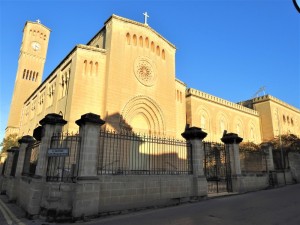 “After enjoying some rest, some of us stand again by the crib to receive the public. More people tend to come at this time, bringing along their families with them. Many people seek this annual opportunity to talk to us. It is pleasant to see that people still trust us and believe that we are a faster way to God,” she said as she smiled.
“After enjoying some rest, some of us stand again by the crib to receive the public. More people tend to come at this time, bringing along their families with them. Many people seek this annual opportunity to talk to us. It is pleasant to see that people still trust us and believe that we are a faster way to God,” she said as she smiled.Indeed, this is the time when people approach them to share their personal problems, seek advice, and ask for prayers. A good number of those attending give them donations to help with the needs of the institute.
“Christmas day ends with more prayers and dinner. Then we gather together to watch tv while enjoying some sweets and a sip of vermouth. After all Christmas is about being with family and this is our family now.”
The Institute of Jesus of Nazareth is located at St Gregory Street in Żejtun.
This year, the mechanical crib will be open between 16th December 2018 and 6th January 2019. Opening hours: 9.30am – noon and 4.00pm – 7.00pm all week.
(This feature was published in the Christmas Times issued with The Times of Malta on 8th December 2018)
-
Gone but not forgotten
“St. George Preca used to say that the cemetery is the biggest book and I had the opportunity to confirm that,” revealed a Capuchin friar who served as a custodian of the Addolorata cemetery for some years. Living among the dead, day and night, helped him to learn much about humanity and its weaknesses.
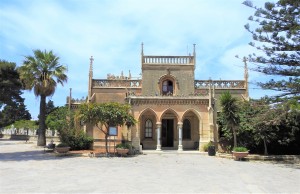 “The Capuchin friars were selected by the British authorities to administer this cemetery because they were loved by the locals. They had always been the ones who stood by the people during the worst moments and in situations which others avoided,” explained researcher Eman Bonnici.
“The Capuchin friars were selected by the British authorities to administer this cemetery because they were loved by the locals. They had always been the ones who stood by the people during the worst moments and in situations which others avoided,” explained researcher Eman Bonnici.“The British authorities hoped to attract people to bury their dead at the Addolorata cemetery. One of the best architects, Emanuele Luigi Galizia, was chosen to design this magnificent cemetery which took seven years to construct at the expense of £33,000. However, a well thought strategy was also required since this necessitated a considerable culture change within Maltese society.”
“Around 150 years ago, no one was buried in a cemetery except for those who died of contagious diseases or prisoners who were hanged. People buried their loved ones within the churches, chapels and crypts of their towns and villages to keep them close and within sacred grounds. Yet authorities considered this custom as a time bomb for some epidemic catastrophe. From time to time, outbursts of plague and cholera appeared on the islands, and it took days before the malady was identified. Case in points were the first plague victims of 1675 and 1813. Both were buried at Ta’ Ġieżu in Valletta, right at the capital city which was densely populated.”
“Initially, the Addolorata cemetery was intended to serve as a burial site for Catholics who were from Cottonera, Floriana and Valletta. As an incentive to start a new chapter in burial custom, those who had a private grave in any of these areas, were offered the possibility to choose a space in this cemetery and their grave would be dug for free. They were also given the privilege to use the cemetery’s church for burial rites and prayers before their loved ones were laid to rest. A further benefit consisted of a daily mass which was celebrated in this church and dedicated to all those who were buried within the cemetery.”
“Although a new law passed in 1863 prohibited further burials within churches, and the Addolorata cemetery was blessed and consecrated in 1869 to be ready for use, it was not that easy to convince the local population who had very strong beliefs related to death and burial customs. No one wanted to bury their dead in the new cemetery. Until one day, a poor woman from Naxxar who lived in Mosta, 64 year old Anna Magro, died at the general hospital, and since she had no relatives, she was the first one to be buried at this cemetery. Some time later, a number of people from Cospicua decided to accept the offer to have their own graves at the Addolorata, and from then, things moved on.”
The custodian’s role of the Addolorata cemetery was quite challenging. He had the responsibility of all the administration of the cemetery which included the registration of burials, the issuing of burial permits, the applications for new graves, the research for the public about the deceased and their graves, the maintenance of the cemetery and its church, the management of the workers, the distribuition of salaries which was still given out in money, the celebration of daily mass, and the hearing of confessions and spiritual advice.
“Originally the friars who acted as custodians were expected to spend the night at the cemetery. I spent around five years living at the cemetery together with a brother who was responsible to cook for me and to take care of the cemetery’s church. Although the brother resided at the cemetery for the whole year, friars alternated every week,” explained the friar.
“I was shocked when I was requested to become a cemetery custodian. I had studied philosophy and theology, and I had no idea whatsoever about the administration of a cemetery. However, my Provincial promised me that he would provide me with all the necessary assistance and so I accepted the role.”
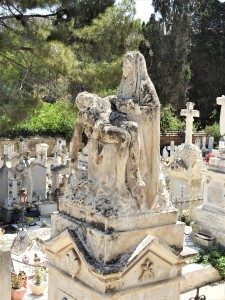 “Ironically, this work was a blessing in disguise! I had never imagined that the very place connected to death would fill my life with such significant experiences. A cemetery gets you in contact with all the levels of society, from the poorest to the richest, from the average person to the most successful. You learn a lot about humanity’s weaknesses and strengths, about love and hate, about repentance and revenge, about the excruciating suffering of illnesses and death. Ultimately, when the time came, it was actually difficult to leave this role.”
“Ironically, this work was a blessing in disguise! I had never imagined that the very place connected to death would fill my life with such significant experiences. A cemetery gets you in contact with all the levels of society, from the poorest to the richest, from the average person to the most successful. You learn a lot about humanity’s weaknesses and strengths, about love and hate, about repentance and revenge, about the excruciating suffering of illnesses and death. Ultimately, when the time came, it was actually difficult to leave this role.”“Some of my experiences at the cemetery are simply unforgettable. Some of them fill me with distate, others chill me to the bone, while a number of them remind me of the unexplainable power of prayer, love, hope and belief. At times, the pain and suffering which I had to deal with became unbearable and I had to seek out the comfort of the convent. More than the freezing cold of the night which reigned within those historical rooms, it was the distressful questions which people confronted me with, day after day, which affected me most.”
“Why is your God doing this to me?” asked a woman while carrying her sixth dead foetus for burial. “Her husband had brought the previous five and I had prayed with him and listened to his suffering. It was the first time that I was facing his wife and the news of yet another miscarriage was intensely sad and shocking. In moments like those, I asked God to guide me and he never failed to assist me. This is not the work of God but of nature, I told her. God would never do this to you! Give a name to each child and pray for each and to each one of them and you will find peace.”
“Around five years passed from this incident. Then, one day, the brother informed me that a couple needed to speak to me. I went out to meet them and they reminded me of their story. ‘I did just like you advised’, the woman told me. ‘And now we have him,’ she said as she reached out to a pram with a beautiful little baby boy inside.”
Stories poured out from the friar. He was still so emotional about them, as if they had just happenned the day before.
“On a very cold and rainy day in February, a smart and well-dressed man came to knock at my door. He gave me a grave number and I informed him that it was located in the common graves’ area. The man asked me to accompany him with a car to see this grave and I drove him there.”
“As soon as I pointed out the grave, the man jumped out of the car, fell to his knees on the ground and began to cry out for his mother’s forgiveness. ‘Forgive me mum! It was not my fault!’ he repeated over and over again while the heavy rain rammed on his back. I felt so distraught for him but eventually I managed to pull him back in the car and help him to calm down.”
“He told me the story of how forty years before, his mother and his wife had a quarrel, and his wife threatened to leave him if he ever got in contact with his mother again. She even forbid him from going to his mother’s funeral, calling him twice at his office on that day to confirm that he had abided to her rules. ‘We have four children and I did not want to mess up my family,’ he informed me, leaving me dumbfounded.”
It was very compelling to witness such hate and thirst for revenge, even after death.
“One day I was asked to give advice to a very affluent man who came to buy a plot to construct a chapel in the cemetery. He was insisting that only he and his wife, their children and their offsprings could be buried in this chapel, leaving out all his sons’ wives, explicitly named in a contract. I told him that this was very uncharitable on his part but he was resolute. I warned him that on knowing about this, his sons would curse him and his wife but he brushed this comment off, ensuring me that he was leaving them all well off.”
“The old couple died and they were buried in the chapel. All went well until one of his sons was widowed. He came to us to make arrangements for his wife’s burial in the family chapel. As soon as he identified himself, I braced myself for trouble since it was clear that he knew nothing about his parents’ decision. He could not believe his ears when we informed him that he could not bury his wife in the chapel. He got so angry and swore so badly, cursing his parents over and over again, that we had to threaten him with the police. Matters worsened further when he realized that this condition affected also all his brothers. He called them all and they came to the cemetery in a frenzy, infuriated at this unexpected news.”
“No matter how much they insisted with us to eliminate this condition, there was nothing we could do. The woman had to be buried in a new grave. All the other brothers bought a new grave too. Their parents’ richly adorned and expensive chapel now lies abandoned and in ruins.”
Nowadays the cemetery is no longer administered by the Capuchin friars.
(This article was published in the SENIOR TIMES – NOVEMBER issued with The Times of Malta on 15th November 2018)
-
Repairing the house before it rains
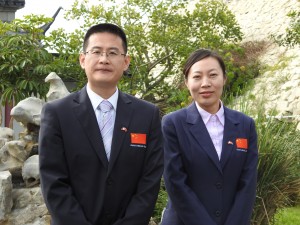 “In China we have this concept to repair the house before it rains. We give great attention to our health and well-being because certainly prevention is always better than cure,” declares Dr Xiaoming Yang, a traditional Chinese medicine physician which is presently giving his services at the Mediterranean Regional Centre for Traditional Chinese Medicine in Kordin, Paola.
“In China we have this concept to repair the house before it rains. We give great attention to our health and well-being because certainly prevention is always better than cure,” declares Dr Xiaoming Yang, a traditional Chinese medicine physician which is presently giving his services at the Mediterranean Regional Centre for Traditional Chinese Medicine in Kordin, Paola.This Centre was established in 1994 as part of a project of cooperation between Malta and China. From then on, every two years, a new Chinese medical team was sent to Malta to replace the previous group in order to continue their duty at this Centre and at clinics in Mater Dei hospital and the general hospital in Gozo. This time, due to new arrangements, this group of Chinese doctors will only stay in Malta for one year until a new group comes to take over.
“Each time, the best Chinese doctors are chosen to come over to Malta since this country is regarded as a very important hub from which to introduce traditional Chinese medicine to other countries as well. Malta’s strategic location makes it ideal to act as a significant connection between Asia, Europe and Africa.”
“Nowadays more and more people are pursuing a healthy lifestyle, and they search for ways in how to keep fit, how to prevent disease and how to prolong life. The key to all these questions is to return to nature because we are part of nature. Nature provides us with all the necessities which are indispensable for our survival. The concept of unity between man and nature is the most basic principle on which this traditional Chinese medicine was founded.”
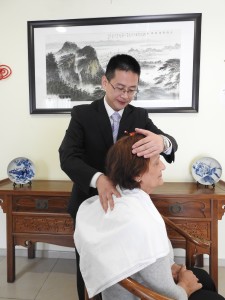 Through his experience at this Centre, Dr Yang noticed that in general Maltese patients, especially the senior population, complain from arthritis, insomnia, frozen shoulder and neck and lower back pain.
Through his experience at this Centre, Dr Yang noticed that in general Maltese patients, especially the senior population, complain from arthritis, insomnia, frozen shoulder and neck and lower back pain.“It is difficult to find a common factor to all these afflictions because many of the patients have different circumstances. However, I did notice some habits and way of life which may lead to these dicomforts, pains and illnesses.”
“In contrast to China, few Maltese people tend to do regular check-ups. Many of them go to the doctor only when they feel pain or some other disturbance. In China, hospitals send out reminders to people to attend to regular tests and many of them comply. This helps the doctor to identify any health problems at an early stage.”
“Another custom in Malta is to attend gyms, often irregularly, without proper supervision or any sensible preparation. Exercising too hard or too long, and training without suitable warming up will eventually lead to health problems. In China, people use traditional martial arts to train the mind, body and soul by doing slow but effective movements which give rise to no strain.”
“Over-exertion is another issue. Although in China I heard that the Maltese enjoy a siesta in the afternoon, in reality I found out that most people have more than one job, starting very early in the morning and continuing late at night. Such long work hours will inevitably lead to over-exertion which will then generate fatigue, strained muscles or disease. Being always so busy makes it also difficult to attend to the required amount of treatments. In fact, while in China, my patients come to my clinic to get treatment around three to five times a week, in Malta, a patient will call to have therapy only once a week or once a month. In my country, people are given permission to leave work in order to have treatment because if a worker is in pain, he may make mistakes. Taking leave to attend therapy does not seem to be as easy in Malta.”
Since regular therapy is essential to heal faster, Dr Yang dedicates himself to teach his Maltese patients how to do self-treatment exercises.
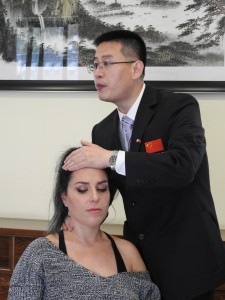 “I have trained Maltese people to make tuina manipulation by themselves generally to treat headache, migraine, neck pain or spinal pain. Knowledge of tuina manipulation involves the pressing of particular acupoints to help release discomfort or pain. This helps to increase the curative effect of my therapy at the Centre.”
“I have trained Maltese people to make tuina manipulation by themselves generally to treat headache, migraine, neck pain or spinal pain. Knowledge of tuina manipulation involves the pressing of particular acupoints to help release discomfort or pain. This helps to increase the curative effect of my therapy at the Centre.”“Tuina manipulation includes the use of hand and arm techniques to massage the muscles and tendons of the body, the stimulation of acupressure points to directly affect the flow of Qi energy through the system of channels and collaterals, and manipulation techniques to realign the musculo-skeletal and bone setting.”
Other services offered at the Centre are acupuncture, cupping, ear acupressure, and moxibustion.
“Traditional Chinese medicine is different from Western medicine since it looks at the body as a whole and does not focus just on the inflicted area. When a patient comes to me, I take time to question him about several factors in his life. I look at his appearance, his tongue, his walk. I ask about his appetite and whether he is suffering from insomnia. Then I continue to search for the root of the problem by touching various acupoints in order to identify where the real trouble is. Sometimes a patient might tell me that he is suffering from a headache but then I realize that the problem is in his neck or that it actually is psychological stress.”
During a recent open day held at the Centre with the theme A Journey into Traditional Chinese Medicine, Dr Yang explained about the different treatments which are being offered at the Centre. He also announced that in March, he would be training Maltese people in traditional Chinese martial arts.
“The intent of traditional Chinese martial arts is to relax and exercise the body in a gentle way by absorbing the energy from the surrounding nature and improving the Qi (energy in the body). For several centuries, these martial arts have helped people to obtain and enjoy a state of good health and well-being.”
 Ms Wei Han, the Chinese interpreter at the Centre provided interesting information about the use of herbs to improve health and well-being.
Ms Wei Han, the Chinese interpreter at the Centre provided interesting information about the use of herbs to improve health and well-being.“Being with these doctors I learnt a lot about traditional Chinese medicine and herbs. In the past, when our ancestors were sick, they went back to nature to find answers in how to regain their health. Through experience and experiments they found the right herbs and they used them as natural medicine to treat illnesses and more important to prevent disease and to maintain health. They also found that certain foods can also be used to treat illness. Some herbs can be used both as food and for medicinal therapy. Ginger for example is often used as spice to give flavour to other foods and obviously it is food. But it can also be used as a herb with medicinal values – it helps us to warm our stomach, to improve digestion and to control nausea.”
As a taster to the participants, the Centre’s chef prepared mutton soup with angelica and ginger, and Chinese berry tea with lily bulbs and red dates.
“We are glad to invite at our Centre all those who are interested to know more about traditional Chinese medicine, traditional Chinese martial arts and traditional Chinese philosophy. Visitors can also enjoy our traditional Chinese garden which though small, it incorporates all the typical philosophical ideas and most important elements. Stones in the garden represent the body of the world, like hills and valleys. Water is the spirit of the world providing oxygen, like blood running through the veins. The pavilion is always located at the best point where one can watch the sunset and the sunrise, and meditate about life or simply relax and have a rest. Our patients find this garden optimal to calm down and to escape from the outside world where pain ceases to exist, at least for a short time,” concluded Ms Han.
For more information, one can contact the Mediterranean Regional Centre for Traditional Chinese Medicine on 2169 1799.
(This feature was published in The Times of Malta in 2018)
-
FROM STORIES TO HISTORY
For hundreds of years, the recording of the past focused on public records, statistical data and the lives of prominent people. Yet in recent decades, the spotlight turned onto the general public and its memories in order to provide a more accurate picture of the historic narrative.
 “People who have lived through particular events can contribute different viewpoints and perspectives that fill in the gaps of documented history, at times correcting or even contradicting the written record. The project MEMORJA aims to give a voice to those who have been unheard,” explained James Baldacchino, the administrator of the MEMORJA Project.
“People who have lived through particular events can contribute different viewpoints and perspectives that fill in the gaps of documented history, at times correcting or even contradicting the written record. The project MEMORJA aims to give a voice to those who have been unheard,” explained James Baldacchino, the administrator of the MEMORJA Project.MEMORJA is an oral, sound and visual archive. Its main objective is to employ cutting edge research, methodologies, theoretical and archival approaches and techniques to collect, record, transcribe, preserve and make available and retrievable all the deposited material detailing the islands’ history.
“Work on this project has begun in January 2017. This is a new platform which is giving an additional dimension to the National Archives since this time, it is not only collecting records but reaching out to create them.”
At the early stages of the project, four themes were selected, namely the Second World War, British expatriates in Malta, public administration and the Lampedusa-Malta connection.
 “The theme related to experiences during the Second World War aims to document and record a past which is slowly disappearing from public memory especially with the passing away of the older generation. Oral testimonies and photographs serve to recollect the terrible years of war and what the people have lived through in those times. Stories of the outbreak of hostilities and the first bombings on June 11, 1940, the mass evacuations and refugee experiences, fear and uncertainty, hunger and the Victory Kitchens, shelters and sanitation, soldiers and sirens, and tragedies of bombings are part of the significant remembrance which needs to be collected and preserved for future generations before it is lost for good.”
“The theme related to experiences during the Second World War aims to document and record a past which is slowly disappearing from public memory especially with the passing away of the older generation. Oral testimonies and photographs serve to recollect the terrible years of war and what the people have lived through in those times. Stories of the outbreak of hostilities and the first bombings on June 11, 1940, the mass evacuations and refugee experiences, fear and uncertainty, hunger and the Victory Kitchens, shelters and sanitation, soldiers and sirens, and tragedies of bombings are part of the significant remembrance which needs to be collected and preserved for future generations before it is lost for good.”The history of the relationship between the UK and Malta is another central theme which has not been documented through the eyes of the British and Maltese individuals.
 “This section includes interviews with British and British-Maltese people who were either in the British forces during the 1960’s (or their spouses) and remained in Malta, or civilians who married a Maltese person and relocated to Malta. Such recordings open a window on everyday life in Malta during the 1950s – 1970s. Much of the narratives relate to military bases, post-war experiences, political issues, relationships and cultural differences. This theme was further expanded when the experience of service families’ children was included as well. These children had attended the Naval Childrens’ School and HM Dockyard Children’s School which had occupied sites at Ta’ Xbiex, Cottonera, Senglea and the Dockyard before moving to Tal-Ħandaq.”
“This section includes interviews with British and British-Maltese people who were either in the British forces during the 1960’s (or their spouses) and remained in Malta, or civilians who married a Maltese person and relocated to Malta. Such recordings open a window on everyday life in Malta during the 1950s – 1970s. Much of the narratives relate to military bases, post-war experiences, political issues, relationships and cultural differences. This theme was further expanded when the experience of service families’ children was included as well. These children had attended the Naval Childrens’ School and HM Dockyard Children’s School which had occupied sites at Ta’ Xbiex, Cottonera, Senglea and the Dockyard before moving to Tal-Ħandaq.” Civil servants are often regarded as those who are implementing the Goverment’s policies. However, through their memories we can get a glimpse of what happenned ‘behind the scenes’ during the most important political, social and economic decisions undertaken by Maltese political leaders.
Civil servants are often regarded as those who are implementing the Goverment’s policies. However, through their memories we can get a glimpse of what happenned ‘behind the scenes’ during the most important political, social and economic decisions undertaken by Maltese political leaders.“These include background revelations of what was taking place during the granting of Independence in 1964, the dismantling of the British military base in 1979 and how the Maltese prepared for such an event, membership in the EU and how it affected the civil service, the migration of the hospital from St Lukes to Mater Dei and many other memorable challenges.”
Lampedusa and Malta are two islands with different political histories. Yet to some extent they share similar economic, trade and socio-cultural interest.
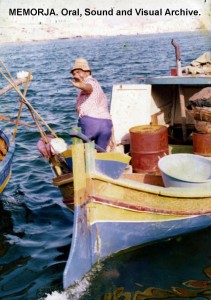 “We have an interest in Lampedusa since in the early 1800s, there were a number of Maltese settlers on this island. Until now, no one had attempted to record these people’s history in order to understand the link between the two islands. The MEMORJA Project is focusing on two time frames to investigate the islands’ shared history. The first one relates to the period from 1800 – 1843 when Lampedusa was colonised by Maltese settlers working in agriculture and animal husbandry. The second covers the period between the 1950s and the 1980s when Lampedusani fishermen visited Malta regularly for the maintenance of ships, the sale of blue fish and the provision of supplies.”
“We have an interest in Lampedusa since in the early 1800s, there were a number of Maltese settlers on this island. Until now, no one had attempted to record these people’s history in order to understand the link between the two islands. The MEMORJA Project is focusing on two time frames to investigate the islands’ shared history. The first one relates to the period from 1800 – 1843 when Lampedusa was colonised by Maltese settlers working in agriculture and animal husbandry. The second covers the period between the 1950s and the 1980s when Lampedusani fishermen visited Malta regularly for the maintenance of ships, the sale of blue fish and the provision of supplies.”As the team of the MEMORJA Project reached out to people, they were soon welcomed by the different communities who were eager to share their recollections.
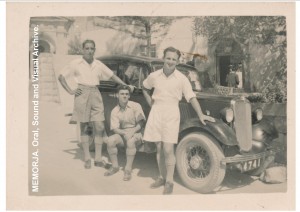 “We found a huge amount of data which existed only in the minds of people and in their photos. Many individuals were enthusiastic to make their voice heard in order to help out with the shaping of the public’s narrative which up to now was not formally recorded for posterity. Even though we have four selected themes, it does not exclude us from recording other memories as well which we deem to be of importance to form part of the community memory.”
“We found a huge amount of data which existed only in the minds of people and in their photos. Many individuals were enthusiastic to make their voice heard in order to help out with the shaping of the public’s narrative which up to now was not formally recorded for posterity. Even though we have four selected themes, it does not exclude us from recording other memories as well which we deem to be of importance to form part of the community memory.”The search for the stories which make the history is still going on. The final goal of the MEMORJA Project which will be officially launched later on this year will be to make this information accessible online for educational and research purposes.
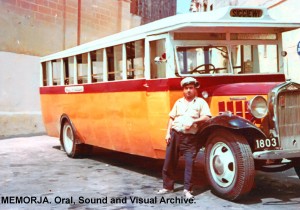 “Oral history allows people to express the personal consequences of change, from the simplest things in life to the more complex. It enables people to share their experiences in their own words, with their own voices, through their own understanding of what happened and why. Eventually, such documentation will offer depth to the understanding of the past to present and future generations.”
“Oral history allows people to express the personal consequences of change, from the simplest things in life to the more complex. It enables people to share their experiences in their own words, with their own voices, through their own understanding of what happened and why. Eventually, such documentation will offer depth to the understanding of the past to present and future generations.”If you are interested to contribute to the MEMORJA Project, you are invited to contact James Baldacchino on james.baldacchino@gov.mt or call 21459863.
The National Archives is located at ‘Santo Spirito’, Hospital Street, Rabat, Malta.
(This article was published in SENIOR TIMES – MAY 2018 issued with The Times of Malta dated 24 May 2018)
-
CORNER COMFORTS
 “You wouldn’t survive in this business if you are not brought up in it since childhood. It is just too demanding and it takes up your life completely,” insisted Frankie Cutajar, the owner of Lady Di Pub in Tignè Street, Sliema.
“You wouldn’t survive in this business if you are not brought up in it since childhood. It is just too demanding and it takes up your life completely,” insisted Frankie Cutajar, the owner of Lady Di Pub in Tignè Street, Sliema.“On the other hand, if the seed of entertainment has been nurtured in your blood from an early age, it is difficult to let go of such an engaging and colourful world,” he said as he laughed heartily and poured a tin of golden beer into a large glass for a client.
Cutajar hails from Valletta. Two of his family members are the renowned late musician Oscar Lucas and popular singer Joe Cutajar.
“Back in the old days, their cheerful attitude and exquisite talent used to light up the thrilling atmosphere of Strait Street. I can still remember the time when 10,000 foreign soldiers sought that area in Valletta each week and all those who had a business there, concocted new ways to attract them to their locale.”
“My uncle Oscar Lucas played in various venues. Together with Jimmy Grech (also known as Jimmy l-Irish), he owned the Las Vegas which was the first nightclub to open in Malta and boasted a capacity of 500 seats. It was huge, running from the area where today one finds the Marks and Spencer store and going up to the Embassy. At the age of 12, I worked as a commis waiter in this nightclub, serving customers which were mainly young couples, between 6:00pm and 8:00pm.”
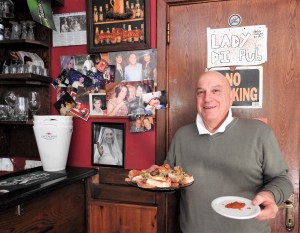 Cutajar got married when he was 18 and kept working at Las Vegas until it closed its doors.
Cutajar got married when he was 18 and kept working at Las Vegas until it closed its doors.“The British Forces’ departure from our islands drained all the energy from Strait Street, turning it into a shadow of what it was. Paceville became the new attraction for the younger generation while Valletta died out during the evenings. Eventually, Jimmy l-Irish, my older brother Harry and I acquired a bar in Melita Street and called it Pippo’s.”
“Later on, my brother and I also took over a business in Tignè Street, Sliema. This place was originally a bar known as Neriku and it was run by my grandfather and grandmother. After it served as an antique shop for some years, we decided to open it as a pub. Many of the visitors who came to Malta and stayed at the surrounding hotels in Sliema were British. So we had no doubts whatsoever about what we were going to name our new pub.”
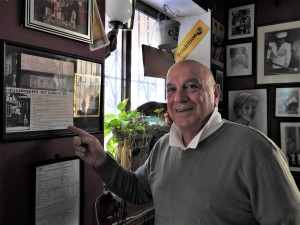 A framed copy of a newspaper feature which hangs on one of the walls narrates how the name Lady Di Pub came to life. Cutajar recounted this incident proudly.
A framed copy of a newspaper feature which hangs on one of the walls narrates how the name Lady Di Pub came to life. Cutajar recounted this incident proudly.“I was having a meal with a well-connected friend of mine at a London restaurant when he introduced me to Lady Diana. I told her that I would be naming a bar after her to record the memorable event of her marriage to Prince Charles. Shortly afterwards, I saw her again at a film premiere in Leicester Square and she reminded me about it.”
Lady Di Pub opened its doors right on Wednesday, 29 July 1981; the day of the eventful fairytale wedding.
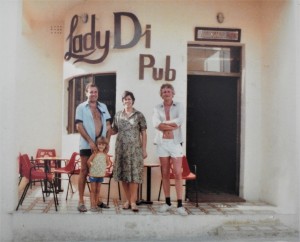 “This is how the pub looked at the time,” Cutajar said as he pointed at another old photo. “It consisted of just two small rooms. However, it had a very good clientele.”
“This is how the pub looked at the time,” Cutajar said as he pointed at another old photo. “It consisted of just two small rooms. However, it had a very good clientele.”Meanwhile, Pippo’s bar in Valletta was turned into Da Pippo’s restaurant and his brother Harry stayed to manage it. Frankie opted to run the pub in Sliema. In 2006, the Lady Di Pub was rebuilt after the property was earmarked for development and was demolished.
“Although the pub was new, I decided to recreate its old British soul. I knew that my clients would appreciate the warm feeling of a unique traditional corner huddled amongst the tall and modern buildings.”
In recent years, Sliema’s architectural context has changed considerably. Huge, inanimate buildings are replacing traditional stately homes, a small number of which still survive in Tignè Street.
“Times change and people have to move on with the progress which is generated. Sliema is not Valletta. Whereas Valletta is a historical city of culture, Sliema is a business hub and a touristic area. The more modernized it is, the more people it attracts, and the more customers will come to this pub,” Cutajar stated as he winked playfully.
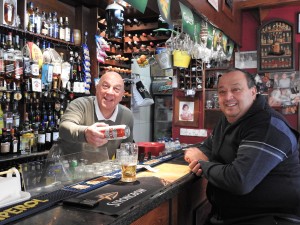 “His charismatic character and that of his son Keith who also works here are the secret of the success of this place,” revealed Ġanni Fenech, a regular client who was having a beer at the bar. “They have a way of making everyone feel welcome and they are also very good in the kitchen. The appetizers in this bar are always bountiful and delicious, urging you to keep on drinking so that the food continues to come out. Seasoned bread, pasta, ricotta and pea pies, cheesecakes… They simply taste like heaven with a glass of beer.”
“His charismatic character and that of his son Keith who also works here are the secret of the success of this place,” revealed Ġanni Fenech, a regular client who was having a beer at the bar. “They have a way of making everyone feel welcome and they are also very good in the kitchen. The appetizers in this bar are always bountiful and delicious, urging you to keep on drinking so that the food continues to come out. Seasoned bread, pasta, ricotta and pea pies, cheesecakes… They simply taste like heaven with a glass of beer.”Right on the point, Frankie came out of the kitchen with a plate of thickly sliced crusty Maltese bread spread with kunserva, a sweet tomato paste, and topped with olives, onions, lettuce and broad beans.
“Especially on Fridays and during weekends, Lady Di Pub is full of people and it stays open until the early morning hours. Some of our clients work in the nearby offices and come here to end the week in a good mood and meet friends. A number of others are regulars from Sliema including a small group of elderly people who have been gathering here each Sunday for the past 30 years! Other locals come from various areas around Malta. However, the majority of our clients are foreigners.”
Frankie starts his day at around 8:30am by doing errands, including buying fresh bread. After enjoying a coffee at a nearby coffee shop, he opens his pub at 10:00am. Soon, the first clients will come in and he starts preparing some inviting appetizers. By now, his long experience and a good knowledge of his clientele have furnished him with an invaluable insight of who will be calling at his pub on each day and what he will need to prepare.
 “We are here to make our clients feel comfortable. Should they wish to have lunch or dinner, we can cook anything to their liking, once they advise us beforehand. Last week, we cooked a selection of pasta, fried rabbit and rib-eye steak for a group, and they surely loved it!”
“We are here to make our clients feel comfortable. Should they wish to have lunch or dinner, we can cook anything to their liking, once they advise us beforehand. Last week, we cooked a selection of pasta, fried rabbit and rib-eye steak for a group, and they surely loved it!”Whilst the younger generation prefer to seek out Keith’s company, the older clientele feels closer to Frankie.
“I am 67 now but still going strong,” Frankie joked as he turned to a laptop and turned on some music. “Back in Valletta, we enjoyed live music at our nightclub. Until some years ago, I had a juke box here. Now I have to rely on this new technology. Flexibility is a must in such a business. Nowadays clients demand to hear particular songs while having a drink and this is the most practical way.”
Culture change is also evident in the choice of requested alcohol and in the clientele’s attitude.
“In the past, people preferred whisky especially Jack Daniels. We also served gin and vodka. Today, very few will ask for gin or vodka and the whisky which we sell is mainly J & B, Jameson, and Johnny Walker Black. Earlier generations used to come in and offer drinks to friends and to other people in the pub. We also had incidents when people got heavily drunk and still insisted to have more drinks. The present generation will generally order and pay for their own drinks, whether male or female. They are also more aware of the risks of over-drinking and they rarely get drunk.”
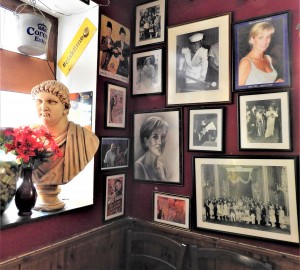 Several framed photos of Lady Diana keep a watchful eye over the pub’s customers.
Several framed photos of Lady Diana keep a watchful eye over the pub’s customers.“These were given to us by her photographer who became our friend,” Frankie explained. “Customers love to look at them especially now that she’s gone. She was very cherished by the people and they still miss her terribly.”
After her tragic death on 31 August 1997, Lady Diana’s fans were distraught. They frantically searched for anything which connected them to her.
“For a number of days after her demise, people left flowers at our doors as a sign of mourning. A British journalist for The People came to visit the pub and interviewed me about this experience. It was certainly a very disturbing loss but in this little corner in Malta, Lady Di’s memory is still very much alive.”
(This feature was published in SLIEMA TIMES – APRIL 2018 issued with The Times of Malta)
-
Ancient practices to relieve modern issues
The Mediterranean Regional Centre for Traditional Chinese Medicine in Kordin, Paola offers a variety of services which aim to improve health and wellbeing. Based on Chinese medical practices which date to more than 2000 years of knowledge, the Centre is run by a team of Chinese doctors who promote an alternative medicine which is well beyond what conventional medicine is about. Besides providing medical treatments, the Centre acts also as a source of information for those who would like to learn more about these ancient practices.
On Sunday, 25 March 2018, a series of three lectures which were organized at the Centre introduced the participants to the themes of neck problem therapies, moxibustion treatments, and the perimenopausal syndrome.
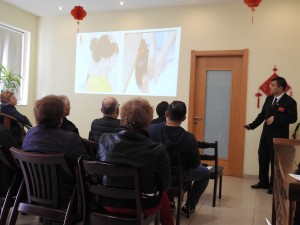 Dr Lu discussed the widespread problem of neck pain and showed some exercises which one can use to avert or to alleviate neck pain.
Dr Lu discussed the widespread problem of neck pain and showed some exercises which one can use to avert or to alleviate neck pain.“Neck pain does not only affect the neck area but it can also lead to several discomforts along other parts of the body. Nowadays many people tend to spend long hours in incorrect postures while looking down at mobiles, sitting at office desks while working on a computer, and watching tv in bed or on a sofa. These are some of the common traits which lead to muscle stress and pain. It only takes little to avoid these mistakes: mobiles should be read at eye level, office chairs should allow workers to sit straight and look comfortably at the computer, tv should not be watched while lying down, and an appropriate pillow should support the spine at the right curve to allow the neck to relax. Ideally, one should change posture regularly to relieve or avoid muscle soreness.”
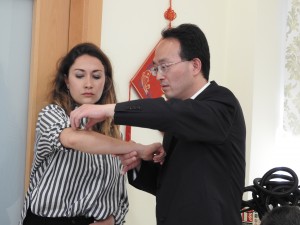 Dr. Zhang explained the benefits of moxibustion treatments and demonstrated how these are applied to patients.
Dr. Zhang explained the benefits of moxibustion treatments and demonstrated how these are applied to patients.“Moxibustion is a traditional Chinese medicine therapy which consists of burning dried mugwort leaf, also known as moxa, to bring relief from pain to the patient. This leaf has a pleasant fragrance and is easy to ignite. Moxibustion is safe and easy to operate. It is also non toxic and has no adverse reactions. However, it should only be done at a professional clinic since there is a risk of getting burnt if not handled properly. Doctors apply moxa to warm meridian points along the body in order to stimulate blood circulation.”
Dr Ma talked about women’s health care and focused on the perimenopausal syndrome which affects a wide section of the female population from the age of 45 to 55. She indicated some exercises which help to relieve stress and also improve memory.
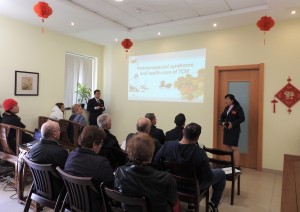 “Perimenopause refers to the time when the body makes the transition to menopause, thereby marking the end of the reproductive years. At this point, women may undergo various symptoms which can make their life stressful and difficult. Sudden hot flashes, insomnia, vaginal dryness and discomfort during love-making, headaches, forgetfulness and emotional instability are some of the main occurrences. Although this change is a natural process, ideally the outcome of menopause should not take place abruptly since this might seriously disturb a woman’s life and also the lives of all those around her. By living a healthy life, eating properly, doing exercise and keeping positive, a woman may help herself to allow a smoother transition which will lead to lesser repercussions. After all, life is what you make it.”
“Perimenopause refers to the time when the body makes the transition to menopause, thereby marking the end of the reproductive years. At this point, women may undergo various symptoms which can make their life stressful and difficult. Sudden hot flashes, insomnia, vaginal dryness and discomfort during love-making, headaches, forgetfulness and emotional instability are some of the main occurrences. Although this change is a natural process, ideally the outcome of menopause should not take place abruptly since this might seriously disturb a woman’s life and also the lives of all those around her. By living a healthy life, eating properly, doing exercise and keeping positive, a woman may help herself to allow a smoother transition which will lead to lesser repercussions. After all, life is what you make it.”More information about the Mediterranean Regional Centre for Traditional Chinese Medicine and its services is available on Facebook or by calling on 2169 1799.
(This feature was published in The Times of Malta on 1st April 2018)
Travelogue
Archives
| M | T | W | T | F | S | S |
|---|---|---|---|---|---|---|
| « Jan | ||||||
| 1 | 2 | 3 | 4 | 5 | 6 | 7 |
| 8 | 9 | 10 | 11 | 12 | 13 | 14 |
| 15 | 16 | 17 | 18 | 19 | 20 | 21 |
| 22 | 23 | 24 | 25 | 26 | 27 | 28 |
| 29 | 30 | |||||
Recent Posts
- A MATTER OF FATE
- MALTA’S PREHISTORIC TREASURES
- THE MAGIC IS IN THE DETAIL
- THE SELLING GAME
- NEVER FORGOTTEN
- Ġrajjiet mhux mitmuma – 35 sena mit-Traġedja tal-Patrol Boat C23
- AN UNEXPECTED VISIT
- THE SISTERS OF THE CRIB
Comments
- Pauline Harkins on Novella – Li kieku stajt!
- admin on IL-KARNIVAL TRAĠIKU TAL-1823
- Albert on IL-KARNIVAL TRAĠIKU TAL-1823
- Martin Ratcliffe on Love in the time of war
- admin on 24 SENA ILU: IT-TRAĠEDJA TAL-PATROL BOAT C23